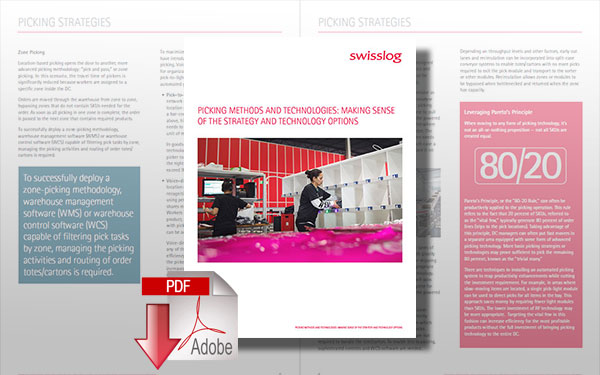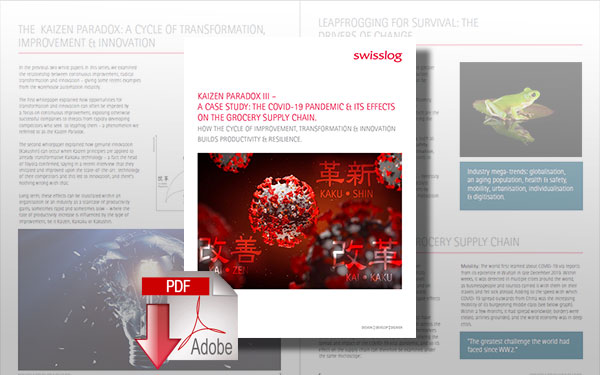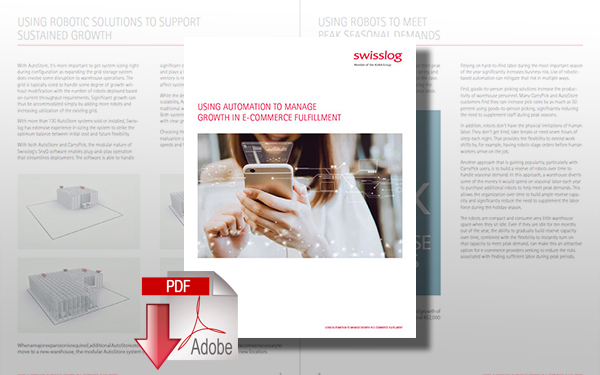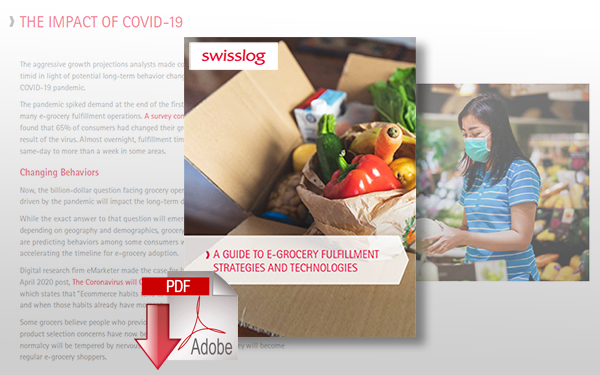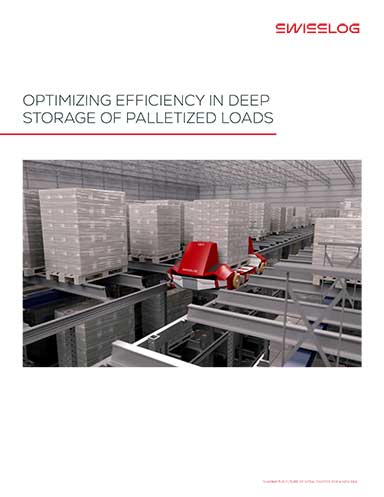Five Trends Shaping E-Grocery Fulfillment in 2022

The top five trends based on our work with industry leaders who have successful MFCs and EFCs operating today.
Five Trends Grocers Should Prepare For
The year 2021 answered some important questions about e-grocery fulfillment and how grocers can most effectively fulfill online orders through micro fulfillment centers (MFCs) and e-grocery fulfillment centers (EFCs).
As my colleague Markus Schmidt noted in his recent post on the major trends emerging across material handling in 2022:
“The majority of the [grocery] market used 2021 to gain a better understanding of the complexities of e-grocery fulfillment and begin to implement the organizational changes required to support an MFC strategy in the future. As a result, 2022 will mark the year when virtually every major grocer finalizes their e-grocery strategy, and many will move into the execution phase using MFC automation.”
With this post I want to explore five trends that grocers should prepare for as they begin to execute on their strategies, based on our work with industry leaders who have successful MFCs and EFCs operating today.
E-grocery Orders Becoming Smaller and More Frequent
The big question coming into 2021 was how much the “return-to-normal” would affect demand for e-grocery services. Would demand drop steeply from the highs experienced during the early days of the pandemic, or would the convenience and time savings offered by online grocery shopping convert first-time users into regular customers?
That question was answered definitively in 2021. Despite online grocery’s share of total sales being up and down on a month-to-month basis, the overall trend was one of growth. According to a report from strategic advisory firm Brick Meets Clicks, the share of the U.S. grocery market represented by e-grocery pickup and delivery grew to 10% of total sales in 2021, up 2 points from 2020. While the firm saw relative consistency in order frequency through 2021, we expect this to change in 2022.
As consumers get more comfortable with online grocery shopping and the convenience it provides, they will place smaller, more frequent e-grocery orders. This could put further pressure on the productivity and efficiency of in-store order picking as a means of fulfilling online orders.
MFCs and EFCs enable greater agility in responding to changing order profiles because the automation systems deployed in these facilities provide the flexibility to scale throughput and inventory independently.
Delivery Time Competition
Another byproduct of the maturing of e-grocery is the growing pressure to reduce order fulfillment times that will occur in 2022. As was seen in the broader e-commerce market, as consumers get more comfortable with, and more dependent on, online shopping they expect faster order fulfillment times. The largest, best-funded players fuel these expectations by continually shrinking delivery times to improve customer experiences and create differentiation.
E-grocery will experience a similar evolution and likely much faster than occurred in other e-commerce segments. Of course, in e-grocery fulfillment, times are measured in hours and minutes rather than days. Grocers relying on manual fulfillment will be hard-pressed to keep pace with customer expectations, particularly in light of changing labor profiles in many markets.
Those moving to automation must ensure their systems are optimized for speed through advanced slotting strategies, maximum automation utilization, and orchestration across upstream and downstream processes. Automated systems must also be easy to use to better accommodate employee turnover and reduce fatigue.
Grocers Cut Through the Hype and Focus on the Business case
In the early months of the pandemic, grocers were developing fulfillment plans as a reaction to an extreme situation. The rapid spike in demand for e-grocery services created a sense of urgency that overshadowed the need for a solid business case.
Speed of deployment was paramount and the situation was too dynamic for a fully developed business case. That led some to adopt quick-to-deploy solutions that didn’t achieve cost-per-order expectations.
That is no longer the case entering 2022. Grocers moving forward with MFCs and EFCs in 2022 will take a more analytical and long-term approach to their e-grocery decisions. The focus is no longer on responding quickly to an unprecedented change in the market, but in establishing and scaling a cost-neutral e-grocery offering.
This shift is increasingly being informed by the experience of early adopters whose facilities met and exceeded expectations. Automation providers that worked with these early adopters are now positioned to help grocers determine the best distribution strategy based on order volumes in each market and accurately project the performance of automated fulfillment centers, both vital components of the business case.
Innovative automation configurations emerge to address key application challenges
The flexibility of the automation deployed in MFCs and EFCs allows these systems to adapt to small and irregularly shaped locations and scale with changes in demand. In 2022, it will also be leveraged in innovative configurations that more tightly integrate manual picking with automation.
One example that is expected to gain traction is placing cube-based automation that would normally be floor-mounted onto a mezzanine. Fast-moving and perishable inventory is then located directly beneath the automation system to improve material flow through the fulfillment center and optimize building and space utilization.
Omni-mode last-mile fulfillment increases the focus on consolidation
When e-grocery fulfillment is limited to curbside pickup, order consolidation and staging can be relatively easy to manage. But when fulfillment hubs are supporting pickup as well as delivery to customers and retail spokes, consolidation, and staging get complex. Managing the timing of orders across the various modes can create confusion and requires more space than many sites have available.
This is increasing the focus on consolidation in e-grocery fulfillment center planning. In 2022 more grocers using a hub-and-spoke distribution strategy will choose to automate consolidation as well as fulfillment. Shuttle systems have proven to be an ideal consolidation engine and will be increasingly paired with cube-based automation systems, such as AutoStore, to efficiently consolidate the ambient, chilled and frozen components of an order based on delivery and pickup schedules.
It may be a little premature to say e-grocery fulfillment has come of age, but it is advancing rapidly as volumes increase and more grocers gain experience operating MFCs and EFCs. In 2022, that progress will be seen in a wave of grocers launching their initial e-grocery distribution centers.
By working with experienced partners and leveraging lessons from early adopters, these organizations can achieve cost efficiencies and performance levels that no one was sure were possible just two years ago.
Meanwhile, grocers that already have MFCs and EFCs in the market will focus on scaling their use of the strategy and using the speed and agility these facilities enable to create a completive advantage. If you’d like to learn more about Swisslog’s experience designing and implementing automation for MFCs and EFCs contact us today.
Related White Papers
Picking Methods and Technologies
With the multiple choices now available, it is imperative that picking strategies be matched with the right technology and software based on the business’s specific challenges. Download Now!
The COVID-19 Pandemic and Its Effects on the Grocery Supply Chain
This white paper examines how Lights-Out Logistics has come into use, and how it can help our supply chains become more resilient in times of great uncertainty and disruption, such as pandemics and financial crises. Download Now!
Using Automation to Manage Growth in E-commerce Fulfillment
Robotic-based automation solutions enable the flexibility to effectively manage both seasonal and sustained growth. Download Now!
A Guide to E-Grocery Fulfillment Strategies and Technologies
This e-book looks at how COVID-19 has become a major disruptor and is accelerating the need for automated e-grocery fulfillment. Download Now!
Related: Micro-Fulfillment Centers Bring the Supply Chain to the Consumer 
Article Topics
Swisslog News & Resources
Walmart chooses Swisslog AS/RS and software for third milk processing facility Walmart and Swisslog Expand Partnership with New Texas Facility Swisslog gives live demonstration of ItemPiQ latest evolution Cardinal Health at-Home Solutions automates from shelf to patient Inside Cardinal Health at-Home: Getting the right products out the door at the right time Retail distribution closes in on the customer Automated storage on the move into 2024 More SwisslogLatest in Warehouse|DC
Microsoft Unveils New AI Innovations For Warehouses Spotlight Startup: Cart.com is Reimagining Logistics Walmart and Swisslog Expand Partnership with New Texas Facility Taking Stock of Today’s Robotics Market and What the Future Holds U.S. Manufacturing Gains Momentum After Another Strong Month Biden Gives Samsung $6.4 Billion For Texas Semiconductor Plants Walmart Unleashes Autonomous Lift Trucks at Four High-Tech DCs More Warehouse|DC

